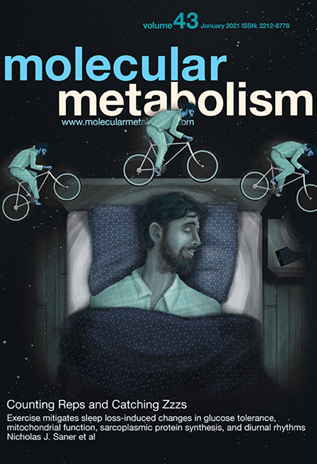Mol Metab. 2021 Jan;43:101112. doi: 10.1016/j.molmet.2020.101112. Epub 2020 Nov 4.
Martin Werdermann 1, Ilona Berger 2, Laura D Scriba 3, Alice Santambrogio 4, Pia Schlinkert 5, Heike Brendel 6, Henning Morawietz 7, Andreas Schedl 8, Mirko Peitzsch 9, Aileen J F King 10, Cynthia L Andoniadou 11, Stefan R Bornstein 12, Charlotte Steenblock 13
Affiliations
1 Department of Internal Medicine III, University Hospital Carl Gustav Carus, Dresden University of Technology, Fetscherstraße 74, Dresden, 01307, Germany. Electronic address: martin.werdermann@uniklinikum-dresden.de.
2 Department of Internal Medicine III, University Hospital Carl Gustav Carus, Dresden University of Technology, Fetscherstraße 74, Dresden, 01307, Germany. Electronic address: ilona.berger@uniklinikum-dresden.de.
3 Department of Internal Medicine III, University Hospital Carl Gustav Carus, Dresden University of Technology, Fetscherstraße 74, Dresden, 01307, Germany. Electronic address: laura.scriba@uniklinikum-dresden.de.
4 Department of Internal Medicine III, University Hospital Carl Gustav Carus, Dresden University of Technology, Fetscherstraße 74, Dresden, 01307, Germany; Centre for Craniofacial and Regenerative Biology, King’s College London, Guy’s Hospital, London, SE1 9RT, UK. Electronic address: alice.santambrogio@kcl.ac.uk.
5 Department of Pharmacology and Toxicology, University Hospital Carl Gustav Carus, Dresden University of Technology, Fetscherstraße 74, Dresden, 01307, Germany. Electronic address: pia.schlinkert@tu-dresden.de.
6 Division of Vascular Endothelium and Microcirculation, Department of Medicine III, University Hospital Carl Gustav Carus Dresden, Dresden University of Technology, Fetscherstraße 74, Dresden, 01307, Germany. Electronic address: heike.brendel@uniklinikum-dresden.de.
7 Division of Vascular Endothelium and Microcirculation, Department of Medicine III, University Hospital Carl Gustav Carus Dresden, Dresden University of Technology, Fetscherstraße 74, Dresden, 01307, Germany. Electronic address: henning.morawietz@uniklinikum-dresden.de.
8 University of Côte d’Azur, INSERM, CNRS, iBV, Parc Valrose, Nice, 06108, France. Electronic address: andreas.schedl@unice.fr.
9 Institute of Clinical Chemistry and Laboratory Medicine, University Hospital Carl Gustav Carus, Dresden University of Technology, Fetscherstraße 74, Dresden, 01307, Germany. Electronic address: mirko.peitzsch@uniklinikum-dresden.de.
10 Department of Diabetes, School of Life Course Sciences, King’s College London, Great Maze Pond, London, SE1 9RT, UK. Electronic address: aileen.king@kcl.ac.uk.
11 Department of Internal Medicine III, University Hospital Carl Gustav Carus, Dresden University of Technology, Fetscherstraße 74, Dresden, 01307, Germany; Centre for Craniofacial and Regenerative Biology, King’s College London, Guy’s Hospital, London, SE1 9RT, UK. Electronic address: cynthia.andoniadou@kcl.ac.uk.
12 Department of Internal Medicine III, University Hospital Carl Gustav Carus, Dresden University of Technology, Fetscherstraße 74, Dresden, 01307, Germany; Diabetes and Nutritional Sciences Division, King’s College London, Guy’s Campus, London, SE1 1UL, UK. Electronic address: stefan.bornstein@uniklinikum-dresden.de.
13 Department of Internal Medicine III, University Hospital Carl Gustav Carus, Dresden University of Technology, Fetscherstraße 74, Dresden, 01307, Germany. Electronic address: charlotte.steenblock@uniklinikum-dresden.de.
Abstract
Objective: Metabolic diseases are an increasing problem in society with the brain-metabolic axis as a master regulator of the human body for sustaining homeostasis under metabolic stress. However, metabolic inflammation and disease will trigger sustained activation of the hypothalamic-pituitary-adrenal axis. In this study, we investigated the role of metabolic stress on progenitor cells in the hypothalamic-pituitary-adrenal axis.
Methods: In vitro, we applied insulin and leptin to murine progenitor cells isolated from the pituitary and adrenal cortex and examined the role of these hormones on proliferation and differentiation. In vivo, we investigated two different mouse models of metabolic disease, obesity in leptin-deficient ob/ob mice and obesity achieved via feeding with a high-fat diet.
Results: Insulin was shown to lead to enhanced proliferation and differentiation of both pituitary and adrenocortical progenitors. No alterations in the progenitors were noted in our chronic metabolic stress models. However, hyperactivation of the hypothalamic-pituitary-adrenal axis was observed and the expression of the appetite-regulating genes Npy and Agrp changed in both the hypothalamus and adrenal.
Conclusions: It is well-known that chronic stress and stress hormones such as glucocorticoids can induce metabolic changes including obesity and diabetes. In this article, we show for the first time that this might be based on an early sensitization of stem cells of the hypothalamic-pituitary-adrenal axis. Thus, pituitary and adrenal progenitor cells exposed to high levels of insulin are metabolically primed to a hyper-functional state leading to enhanced hormone production. Likewise, obese animals exhibit a hyperactive hypothalamic-pituitary-adrenal axis leading to adrenal hyperplasia. This might explain how stress in early life can increase the risk for developing metabolic syndrome in adulthood.
PMID: 33157254
DOI: 10.1016/j.molmet.2020.101112

